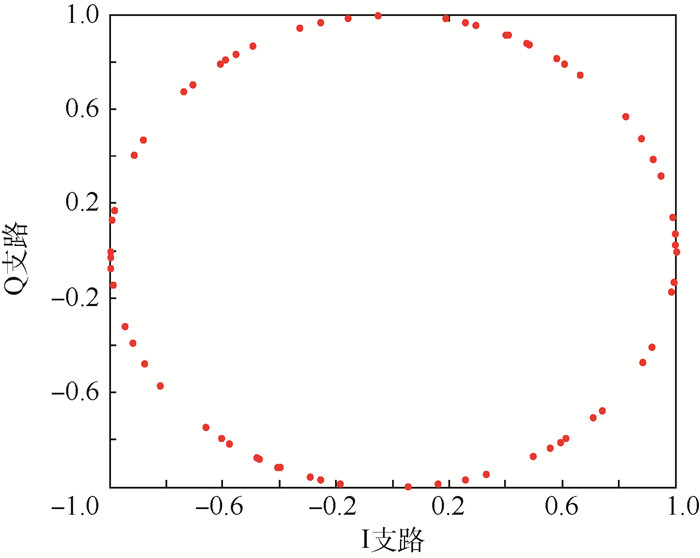-
摘要:
现代化的卫星导航信号要求在星上高功率放大器之前恒包络复用同频点甚至临近的双频点/三频点的多个导航信号分量。最优相位恒包络发射(POCET)技术能够恒包络复用任意路数信号且达到最高复用效率。已见诸报道的POCET最优相位搜索的数值算法存在计算量大、收敛速度慢、当迭代点远离最优解或要求提高计算精度时难以收敛到局部最优解等问题。针对导航信号最优恒包络复用论证的需求,首先在优化目标函数中引入增广拉格朗日乘子法以解决当终止误差减小无法收敛到局部最优解的问题;其次对于搜索步长的确定摈弃了已有的精确线搜索算法而采用基于Armijo准则的非精确线搜索算法,并比较研究了最速下降法、共轭梯度法、拟牛顿法(包括BFGS法和对称秩1法)等多种搜索方向优化算法的优缺点和适用性;最后通过对BDS B1频点不同功率分配下的最优相位搜索和合成损耗评估,验证了改进后算法的精度高、计算量小、收敛性强等优点,为导航信号调制复用方案的设计和优化提供参考。
Abstract:Usually a modern navigation satellite needs to combine multiple signal components at the same carrier frequency or even two/three adjacent frequencies into a constant-envelope signal before its high power amplifier. The phase-optimized constant-envelope transmission (POCET) technique can deal with any number of signal components and achieve the highest power efficiency. The existing numerical algorithms for POCET phase searching, however, have some problems such as large amount of computation, slow convergence rate, and possible failure of convergence when the initial point is far from the optimal solution or when higher accuracy is required. Aimed at the argumentation of optimized multiplexing for satellite navigation signals, this paper firstly introduces the augmented Lagrange multiplier method to ensure convergence with smaller termination error. Next, the inexact line search algorithm based on Armijo criterion is adopted instead of the exact line search for determination of search steps. Then, the characteristics and applicability of several search direction optimization algorithms are comparatively analyzed, such as the steepest descent method, the conjugate gradient method, and the quasi-Newton method (including the BFGS method and the symmetric rank 1 method). Finally, the high accuracy, low computational complexity, and strong convergence of the improved algorithm are validated by its application in the search of optimal phase-table and evaluation of combining loss of BDS B1 signals under different power allocation and phase constraints. The study provides a reference for the design and optimization of the navigation signal modulation.
-
Key words:
- POCET technique /
- optimization algorithm /
- multiplexing /
- combining loss /
- numerical algorithm
-
表 1 优化算法对比
Table 1. Comparison of optimization algorithms
优化算法 搜索方向 优缺点 适用性 最速下降法[6] 负梯度方向 结构最简单,编程容易,初始点要求不高;收敛速度慢,有时达不到最优解 信号路数 < 7路 共轭梯度法[8-9] 共轭性与最速下降法相结合,搜索方向满足: 
收敛速度快,存储量小,稳定性高,对初始点要求不高;相比最速下降法,增加了计算量 均适用 BFGS法[8-10] 近似矩阵的构造: 
相比较前2种算法,收敛速度最快,搜索方向与牛顿法搜索方向近似相同,算法稳定性高,对初始点要求不高 对称秩1法[8-10] 近似矩阵的构造: 
注:∇f(xk+1)和∇2f(xk+1)—xk+1处的一阶导数和二阶导数;Bk—近似矩阵;位移sk=xk+1-xk;梯度差yk=∇f(xk+1)-∇f(xk)。 表 2 复用方案
Table 2. Multiplexing scheme
复用方案 B1I B1C_TMBOC B1C_QMBOC B1A_时分 B1A_相分 路数 方案1 √ √ √ 5 方案2 √ √ √ 6 方案3 √ √ √ 6 方案4 √ √ √ 7 表 3 4种优化算法的结果
Table 3. Results of four optimization algorithms
优化算法 迭代次数 收敛时间/min 目标函数值 BFGS法 211 1 0.192 对称秩1法 73 1 0.192 共轭梯度法 1160 5 0.192 最速下降法 40 031 56 0.192 -
[1] FAN T, LIN V S, WANG G H, et al.Study of signal combining methodologies for future GPS flexible navigation payload (Part Ⅱ)[C]//Proceedings of IEEE/ION on Position, Location & Navigation Symposium.Piscataway, NJ:IEEE Press, 2008:1079-1089. [2] DAFESH P A, CAHN C R.Phase-optimized constant-envelope transmission (POCET) modulation method for GNSS signals[J].Proceedings of International Technical Meeting of the Satellite Division of the Institute of Navigation, 2009, 5538(1):2860-2866. doi: 10.1007/978-3-662-46635-3_3/fulltext.html [3] ZHANG K, ZHOU H W, W F X.Multiplexing performance assessment of POCET method for compass B1/B3 signals[J].Journal of Navigation, 2011, 64(S1):S41-S54. doi: 10.1017/S0373463311000427 [4] CAI M, XIE J, WANG G.Application study of a phase-optimized constant-envelope transmission(POCET) optimization algorithm for BDS B1 signal[C]//2015 Proceedings of China Satellite Navigation Conference (CSNC):Volume Ⅱ.Berlin:Springer, 2015:491-493. [5] LIU Y, LI C Z, NIU H F.Research and implementation of POCET constant envelope modulation technique[J].Radio Communications Technology, 2013, 39(5):85-88. [6] 马昌凤.最优化方法及其Matlab程序设计[M].北京:科学出版社, 2010:32-55.MA C F.Optimization method and Matlab program design[M].Beijing:Science Press, 2010:32-55(in Chinese). [7] BERTSEKAS D P.Constrained optimization and Lagrange multiplier methods[M].New York:Academic Press, 1982:280. [8] 王宜举.非线性最优化理论与方法[M].北京:科学出版社, 2012:30-75.WANG Y J.Nonlinear optimization theory and method[M].Beijing:Science Press, 2012:30-75(in Chinese). [9] 陈宝林.最优化理论与算法[M].北京:清华大学出版社, 1989:300-350.CHEN B L.Optimization theory and algorithm[M].Beijing:Tsinghua University Press, 1989:300-350(in Chinese). [10] NOCEDAL J, WRIGHT S J.Numerical optimization second edition[EB/OL].New York:Springer Science+Business Media, 1999(2012-09-12)[2016-08-02]. [11] 谢钢.全球导航卫星系统原理[M].北京:电子工业出版社, 2013:40-43.XIE G.Principles of global navigation satellite system[M].Beijing:Publishing House of Electronics Industry, 2013:40-43(in Chinese). [12] TAN S S, ZHOU B, GUO S T, et al.Studies of compass navigation signals design[J].Scientia Sinica, 2010, 40(5):514-519. [13] LU M Q, SHEN J.Optimized modulation and multiplexing for COMPASS B1C signal[C]//Proceedings of the 25th International Technical Meeting of the Satellite Division of the Institute of Navigation (ION GNSS 2012).Piscataway, NJ:IEEE Press, 2012:1876-1904. [14] YAO Z, LU M, FENG Z M.Quadrature multiplexed BOC modulation for interoperable GNSS signals[J].Electronics Letters, 2010, 46(17):1234-1236. doi: 10.1049/el.2010.1693 [15] ZHANG K, LI Y, ZHOU H, et al.Analytical transmission model of POCET technique for compass B1 and B3 signals[C]//Proceedings of the 25th International Technical Meeting of the Satellite Division of the Institute of Navigation.Piscataway, NJ:IEEE Press, 2012:277-285. -








 下载:
下载:



